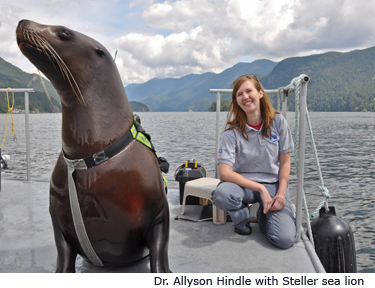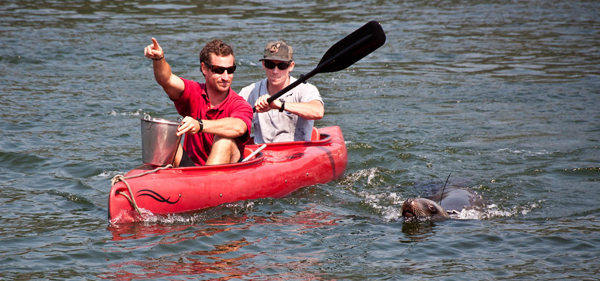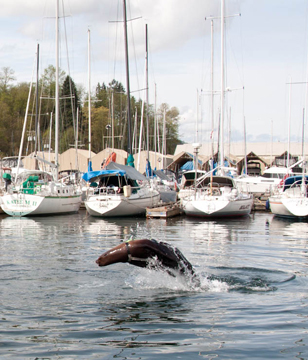
As Steller sea lions decline in parts of the North Pacific Ocean, Consortium scientists are working to understand how sea lions can be affected by changes in their ocean environment.
Swimming and diving are key activities that consume a good deal of metabolic energy. By measuring the energetic “costs” associated with foraging dives and with surface swimming between locations, scientists can estimate the potential impacts of shifts in the ocean environment. A change in ocean currents or ice patterns could affect the location of important prey, or restrict access to key foraging grounds.
Working with trained Steller sea lions in an open water environment, Consortium researchers conducted two studies investigating the energetic cost of transiting between locations, and the physiological response to shallow and deep dives. The studies were published in Aquatic Biology and the Journal of Experimental Marine Biology and Ecology.
Cost of Commuting
Commuting between shore and prey fields accounts for a significant portion of a sea lion’s energy budget. For nursing females who cannot leave their pups for long, it is especially important to make each trip as energy efficient as possible.
 “Considerable research has focused on the energetics of otariid diving, particularly on the relationship between diving exercise and foraging effort,” writes lead author Dr. Allyson Hindle of the Marine Mammal Research Unit at UBC, who led both studies. “On the other hand, studies directly addressing transit swimming are less numerous, with many confined by experimental logistics to surface swimming only.”
“Considerable research has focused on the energetics of otariid diving, particularly on the relationship between diving exercise and foraging effort,” writes lead author Dr. Allyson Hindle of the Marine Mammal Research Unit at UBC, who led both studies. “On the other hand, studies directly addressing transit swimming are less numerous, with many confined by experimental logistics to surface swimming only.”
Hindle and colleagues overcame those experimental logistics by conducting their study in open water with Steller sea lions trained to follow a moving boat at different speeds and depths. The scientists measured the duration of each transit dive as well as overall body activity. The study used activity as a proxy for metabolic expenditure, and the researchers measured fore-flipper stroking and overall dynamic body acceleration (ODBA) in three dimensions.
“Sea lions appeared to increase efficiency while transiting at depths that approached three times their body diameters,” the authors report, suggesting an optimal depth for commuting to and from foraging areas. Transiting at faster speeds required more frequent and powerful flipper strokes, while transiting against the tidal flow produced either a more powerful stroke or a parallel increase in stroke frequency.
“Our data demonstrate that small changes in the physical environment affect transiting in Steller sea lions,” note the authors, “and imply that altered prey fields or changing ocean conditions can carry energetic consequences.”

Dive Dilemna
In a separate study, Hindle and colleagues measured behavioral and physiological changes in the same trio of Steller sea lions during shallow and deep dives. Like all marine mammals, the physiology of Steller sea lions is adapted to prolonged breatholding and underwater activity. The automatic dive response, called bradycardia, automatically slows the heart rate and shunts blood away from non-essential areas to conserve oxygen.
This seemingly contradictory response to exercise – which in an aerobic environment would elevate the heart rate and increase circulation – presents a physiological conundrum. Of particular interest to scientists is the point at which the dive response overrides the exercise response.
 “Our study objective was to determine the relationship between heart rate and underwater locomotion in a diving Steller sea lion,” the authors write. They measured diving heart rate using heart rate monitors and measured activity using ODBA and flipper stroking. They also compared the patterns of bradycardia over single dives and bouts of consecutive dives.
“Our study objective was to determine the relationship between heart rate and underwater locomotion in a diving Steller sea lion,” the authors write. They measured diving heart rate using heart rate monitors and measured activity using ODBA and flipper stroking. They also compared the patterns of bradycardia over single dives and bouts of consecutive dives.
The dive depth and distance simulated realistic wild scenarios for foraging Steller sea lions. The sea lions in this study displayed bradycardia during all dive trails regardless of depth, but the degree of bradycardia varied with depth.
“We found the mean heart rate of Steller sea lions trained to voluntarily dive to depths of up to 40m dropped by 40% while diving, and noted that mean bradycardia was 9% greater during shallow (10m) compared to deep (40m) dives,” write Hindle and colleagues. “Longer dives resulted in lower heart rates, but only when they were shallow; on the other hand, minimum instantaneous heart rate decreased consistently with dive duration.
“Ultimately,” the authors conclude, “our data support the speculation that Steller sea lion locomotory muscles become hypoxic during diving, regardless of dive depth.”
January 14, 2011
![]() RELATED PUBLICATIONS:[webref_bio title=” Dive response differs between shallow- and deep-diving Steller sea lions ({iEumetopias jubatusi})”]
RELATED PUBLICATIONS:[webref_bio title=” Dive response differs between shallow- and deep-diving Steller sea lions ({iEumetopias jubatusi})”]
[webref_bio title=” Swimming depth and ocean currents affect transiting costs in Steller sea lions ({iEumetopias jubatusi})”]
